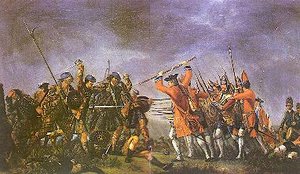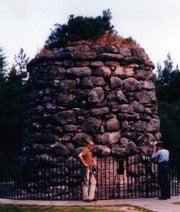Battle of Culloden
|
|

| |||||||||||||||||
| Battle of Culloden | |||||||||||||||||
|---|---|---|---|---|---|---|---|---|---|---|---|---|---|---|---|---|---|
| Conflict | Jacobite Risings (Second Jacobite Uprising) | ||||||||||||||||
| Date | April 16, 1746 | ||||||||||||||||
| Place | Culloden, Scotland | ||||||||||||||||
| Result | Decisive Hanover victory | ||||||||||||||||
| |||||||||||||||||
The Battle of Culloden (April 16, 1746), was the last military clash in mainland Britain, between the forces of the Jacobites and those of the reigning Hanoverians in the '45 Jacobite Rising. It was a massive defeat for the Jacobites, ending the rebellion.
Accounts of this battle and its aftermath vary and are contradictory on some points. This article attempts to provide a reasonable summary.
| Contents |
Background
For further detail see Jacobite Rising.
Prince Charles Edward Stuart, known to his supporters as Bonnie Prince Charlie and to his opponents as the Young Pretender, successfully raised forces, mainly of Scottish Highland clansmen, which took Edinburgh and defeated the small government army in Scotland at the Battle of Prestonpans. The government began bringing forces back from the war with France in Flanders to deal with the Jacobite rebellion.
After a lengthy wait Charles persuaded his generals that English Jacobites would stage a rising and the French would invade to assist them. His army of around 5000 invaded England on November 8, 1745 and advanced through Carlisle and Manchester to Derby, a position where they appeared to threaten London, leading King George II to make plans to decamp to Hanover. English Jacobites had been prevented from giving much support and the French invasion fleet was still being assembled, the armies of General George Wade and of William Augustus, Duke of Cumberland were approaching, a militia was forming in London and they had (fictitious) reports of a third army closing on them. The Jacobite general Lord George Murray and the Council of War insisted on returning to join their growing force in Scotland and on 6 December 1745 they withdrew, with the Prince petulantly leaving the command to Murray.
The Jacobite forces reached Glasgow by Christmas Day, reprovisioned, and were boosted by a few thousand extra men. They then clashed with the forces of General Henry Hawley near Falkirk and were victorious. The Duke of Cumberland arrived in Edinburgh on 30 January to take over command of the government army from General Hawley, then marched north along the coast with the army being supplied by sea. They assembled at Aberdeen and spent six weeks in careful training. This was unusual at this date, but as the king's son Cumberland had the authority to ensure the best training and equipment.
Hanoverian forces continued to pressure Charles, and he retired northwards, losing men and failing to take Stirling Castle or Fort William but investing Fort Augustus and Fort George in Inverness by early April. Charles now took charge again, insisting on fighting an orthodox defensive action.
Armies
This last major clash of arms on British soil was contested between between supporters of rival claimants to the British throne rather than between two nations. Nonetheless, most of the soldiers in the Jacobite Army were Scottish and most of those in the Hanoverian Army were English.
Nearly three quarters of the Jacobite army was formed of Scottish Highland clansmen, the majority of them being Roman Catholic but more than a third being Scottish Episcopalians. Only 20-25% of the highlanders were armed with swords, some having spears or axes and the remainder makeshift or captured weapons. Around a quarter of the total force was Episcopalians from the north-east Scottish Lowlands north of the River Tay so that more than half the total was Episcopalian, but the lowland contribution was obscured by their tendency to wear Highland dress as a kind of Jacobite uniform. During the invasion of England about 250 Episcopalians from Manchester formed a regiment, but were left behind for a rearguard action at Carlisle. At the end of November French ships arrived in Scotland with 800 men from the Eccosais Royeaux (Royal Scots) and Irish Regiments of the French army. Many of the Highlanders had left for home after Falkirk, and the army was badly provisioned and on short rations.
The British Army under Cumberland assembled and trained at Aberdeen was well supplied. Twelve battalions of foot, three regiments of horse and a company of artillery were largely English (possibly also including German Hanoverians), three battalions of foot were Lowland Scots, one battalion and a militia had been largely raised from Clan Campbell Highlanders.
CullodenBattlefield.jpg
Battle
The Duke of Cumberland and his army of around 8,000 arrived at Nairn on 14 April. The Jacobite forces of about 5,400 left their base at Inverness, leaving most of their supplies, and assembled 5 miles (8 km) to the east near Drummossie, around 12 miles (19 km) before Nairn. Prince Charles had decided to take personal command of his forces and took the advice of his adjutant general, Secretary O’Sullivan, who chose to stage a defensive action at Drummossie Moor, a stretch of open moorland enclosed between the walled Culloden enclosures to the North and the walls of Culloden Park to the South. Lord George Murray "did not like the ground" and with other senior officers pointed out the unsuitability of the rough moorland terrain which was highly advantageous to the Duke with the marshy and uneven ground making the famed Highland charge somewhat more difficult while remaining open to Cumberland’s powerful artillery. They had argued for a guerilla campaign, but the Prince refused to change his mind.
On 15 April the government army celebrated Cumberland's birthday, drinking his health at his expense. At the suggestion of Murray the Jacobites tried that evening to repeat the success of Prestonpans by carrying out a night attack on the government army encampment, but the half-starved Highlanders who had only had one biscuit apiece during the day were still 2 miles (3 km) short of Nairn by dawn and had to march back, then dispersed to search for food or fell asleep in ditches and outbuildings. Many of them lay exhausted in the grounds of Culloden House throughout the battle.
Early on 16 April the government army marched from Nairn, and Jacobite guns sounded the alarm (though not all heard) to bring their troops to form two lines. The front line of exhausted highland foot soldiers had guns in the centre and on the flanks, the second line included their horse regiments, worn out from the night march, and the Scots and Irish regiments of the French army. The weather was very poor with a gale driving sleety rain into the faces of the Jacobites. The Duke's forces arrived around mid day and arrayed themselves in two lines to face the Jacobite forces, their left flank anchored on a low stone wall running along the south end of the field towards Culloden Park. Horse Dragoons and Campbell militia moved round behind the wall to infiltrate the park around the Jacobite flank. The Prince's artillery, outnumbered some three to one, opened fire first but due to a lack of trained gunners had little impact.
Over the next twenty minutes the superior artillery of the Hanoverian forces continued to batter the Jacobite lines, while Charles, moved for safety out of sight of his own forces, waited for the government forces to move. He was eventually persuaded to issue the order to charge. The McDonalds refused, angry because they had been placed on the left flank overturning their traditional right to take the right flank. The Clan Chattan was first away, but an area of boggy ground in front of them forced them to veer right so that they obstructed the following regiments and the attack was pushed towards the wall. The Highlanders advanced bravely on the left flank of the Hanoverian troops but were constantly subjected to heavy volleys of musket fire and the artillery which had switched from roundshot to grapeshot. Many Jacobites did reach the Hanoverian lines, and they fought bravely, but the Duke was well aware of the Highland sword charge, having commanded the Black Watch at the Battle of Fontenoy, and the Hanoverian troops had been trained in new bayonet tactics to withstand the charge. Each soldier would use his mounted bayonet on the highlander attacking the soldier to his right, getting behind the guard of the highlander's targe (shield), while relying on his comrade to his left to deal with any attack on himself.
While the attack was still in progress, a small number of the Hanoverian forces had breached the park wall and the Campbell militia advanced unseen to fire at the right flank of the Jacobite lines. This added to all the other brutal gunfire, and threatened by cavalry the Jacobites were forced to retreat. The Duke ordered in his cavalry to rout the Jacobite forces, but the small contingent of elite Irish and other regular regiments covered the retreat as the Jacobites withdrew.
In a total of about 60 minutes the Duke was victorious, around 1,250 Jacobites were dead, a similar number were wounded, and 558 prisoners were taken. The Duke lost about 52 dead and 259 wounded among his Hanoverian forces.
Aftermath
After their victory, Cumberland ordered his men to execute all the Jacobite wounded and prisoners, an act by which he was known afterwards as "the Butcher". Certain higher-ranking prisoners did survive to be tried and executed later in Inverness. The Prince fled the battlefield and survived for five months in Scotland despite a Ł30,000 reward for his capture. The Prince eventually returned to France, making a dramatic if humiliating escape disguised as a "lady's maid" to Flora Macdonald.
Immediately after the battle, Cumberland rode into Inverness, his drawn sword still covered in blood, a symbolic and menacing gesture. The following day, the slaughter continued, when patrols were sent back to the battlefield to kill any survivors; contemporary sources indicate that about 70 more Jacobites were killed as a result of this. Cumberland emptied the jails of English prisoners, and replaced them with Jacobite sympathisers. Numbers of the prisoners were brought south to England to stand trial, charged with high treason, with trials taking place at Berwick, York and London. Executions were conducted on the basis of drawing lots on a ratio of about 1 in 20. In total 3,470 Jacobites, supporters and others were taken prisoner in the aftermath of Culloden, with 120 of them being executed and 88 dying in prison; 936 transported to the colonies and 222 more "banished". While many were eventually released, the fate of nearly 700 is unknown. As well as dealing out summary justice to his captives, Cumberland was equally ruthless with deserters from his own forces found amongst the prisoners, executing 36 of them.
The Hanoverian forces' assault on the Jacobite sympathizers continued in the coming months—destroying the clan system with the Act of Proscription disarming them, banning the kilt and the tartan, the Tenures Abolition Act ending the feudal bond of military service and the Heritable Jurisdictions Act removing the virtually sovereign power the chiefs had over their clan. Statute provisions were aimed at proscribing the perceived religion of the Jacobites, Episcopalianism (Catholicism was already banned). Government troops were stationed in the Highlands and built more roads and barracks to better control the region, adding to the Wade roads constructed for Major-General George Wade after the 'Fifteen rising, as well a new fortress at Fort George to the east of Inverness.
ClanGraves.jpg
References
- Culloden, John Prebble, Atheneum 1962, ASIN B0007DT6U0
- The Lion in the North, John Prebble, Penguin Books 1973, ISBN 0140036520
- Scotland, A Concise History, Fitzroy Maclean, Thames and Hudson 1991, ISBN 0500277060
fr:Bataille de Cullodenpl:Bitwa pod Culloden he:קרב קלודן
External links
- Britishbattles.com: Battle of Culloden (http://www.britishbattles.com/battle_of_culloden.htm)
- Culloden feature page on Undiscovered Scotland (http://www.undiscoveredscotland.co.uk/inverness/culloden/)
- Bloody Culloden (http://www.highlanderweb.co.uk/bloody/culloden/home.htm)
- Culloden Moor and the Story of the Battle (1867 account) (http://www.queenofscots.co.uk/culloden/cull.html)

